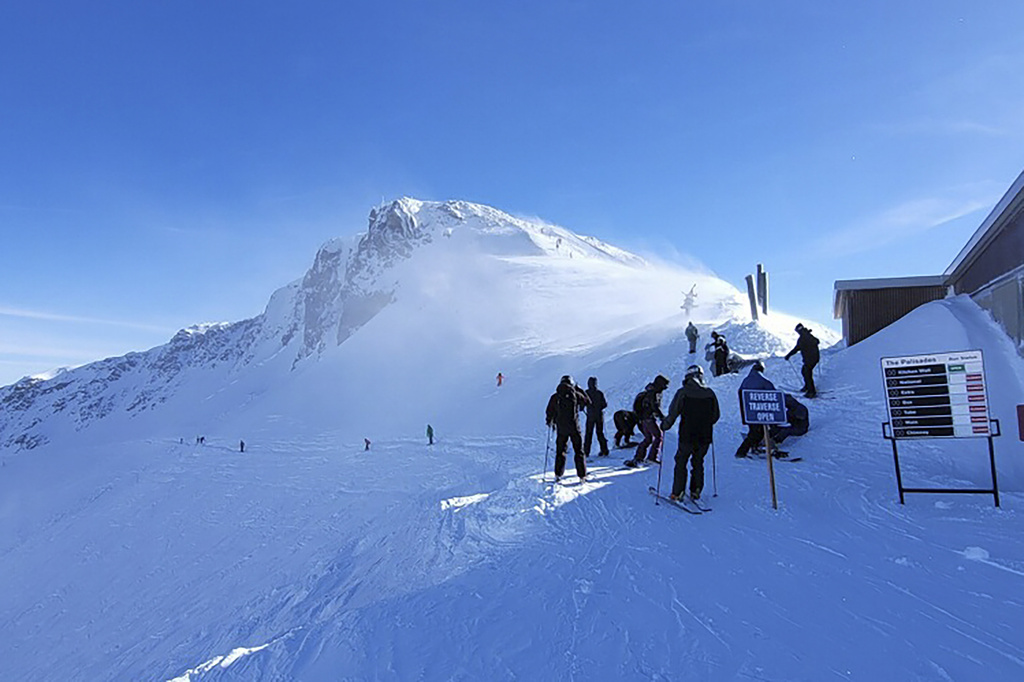While we were celebrating the end of a sunny New Year’s Eve weekend, the snow in the Sierra Nevada suddenly turned as brittle and spiky as the old ice cream in your freezer.
That Jan. 1 phenomenon — when snow vaporized upward at night, refreezing into a layer of fragile crystals — is blamed for this month’s frightening proliferation of avalanches that are occurring across a broad swath of the Lake Tahoe landscape, including one that killed a skier at Palisades Tahoe.
There have been more than 50 so far, and it may get worse: This weekend’s rain and heavy snow could add weight and stress to the buried crystals, known as “surface hoar,” which act like weak stilts and easily collapse. Over time, the problem may ease. Or it could plague our snowpack for a few weeks, a few months, or even the entire season.
“Just another reminder — things aren’t the Tahoe norm,” wrote Jan Czyzewski of Blackbird Mountain Guides in a report last week to the Sierra Avalanche Center, after witnessing signs of five different avalanches, including one that was 500 feet wide, while skiing in Ward Canyon on Tahoe’s West Shore.
Weather on the night of Jan. 1 provided the perfect recipe for the creation of surface hoar: Clear and cold skies, high relative humidity and calm winds, according to Brandon Schwartz, director and lead avalanche forecaster for the Sierra Avalanche Center in rugged Tahoe National Forest.
Then it snowed. On Jan. 2, the layer of delicate crystals was buried beneath fresh powder. Another weak layer, far deeper, was created by frozen rain on Dec. 19.
On Thursday, the Sierra Avalanche Center warned that “triggering a large avalanche remains possible today where weak snow is buried below the snow surface. “Signs of unstable snow may not be obvious,” it added. “With each passing storm, these weak layers become buried deeper in the snowpack.”
Since Jan. 2, 52 avalanches have been observed in the Central Sierra, including the deadly Palisades slide and numerous less publicized close calls. This compares to 36 avalanches during the same time period last year and 10 in 2022, although the Center’s newly improved reporting system may have helped boost this year’s count.
On Monday, two avalanches were reported in the wilderness beyond Kirkwood and a third in Euer Valley, north of Truckee. Multiple other avalanches, both natural and human-triggered, were reported in the Relay Peak area near Incline Village.
Twelve avalanches were documented on Sunday, including a skier-triggered slide in a bowl near Soda Springs that sent snow sliding 500 feet and a snowmobile-triggered, 200-foot wide break across a chute above Homewood.
“I’ve never felt whoomphing like I did today,” when the upper snowpack collapsed on Sunday due to a fractured buried snow layer, according to a report filed to the Avalanche Center by an unnamed skier at Highland Lakes, beyond Bear Valley. “Multiple times we felt entire slopes whoomph, almost reminding us of an earthquake as it seems like the entire slope moved.”
One large collapse near Stevens Peak, east of Kirkwood, caused a slide the size of a football field, reported Travis Feist of the Avalanche Center.
Such dangers are familiar in Colorado and other Rocky Mountain states, according to Clinton Alden of the University of Washington, who studies snowpack evolution and ice layer formation in seasonal snow cover.
Compared to the maritime mountains along the West Coast, the Rockies have a colder and shallower snowpack, which is more likely to develop layers of instability, said Alden. Colorado suffered 64 avalanche fatalities between 2013-14 and 2022-23, compared to 9 in California.
Surface hoar forms regularly in the Sierra, said Schwartz. But it is usually destroyed by wind and warming air temperatures prior to new snowfall.
How do clear cold nights and shallow snow increase risk?
Surface hoar is created when water vapor is deposited on the snow surface, like dew. The vapor quickly turns into ice, skipping the liquid phase completely, said Alden. It’s an atmospheric event, transforming the surface of old snow into a crystalline layer that lacks cohesion and strength.
“It’s analogous to the feather-like crystals that grow in your freezer,” said Neil Lareau, a professor of atmospheric science at the University of Nevada in Reno. If quickly buried by the new snow, these crystals become a hidden peril.
A secondary and lesser culprit was the creation of loose, dry and sugary “faceted” crystals in clear and cold weather, also buried by snow on Jan. 2, said Schwartz. These fragile “facets” are made when molecules of water vapor move through the snow, re-aligning themselves,and are mostly likely to form in shallow snow.
because there’s a dramatic temperature gradient in the short distance between the ground and air, according to Alden. The ground quickly loses heat at night — and if skies are cloudless, it cools still faster. This process is much slower when snowpack is deep.”]
Our famed “Sierra cement” can establish a protective foundation for all subsequent winter storms. It’s heavy and abundant, with six-armed stellar flakes that are large, strong, interlocked and cohesive.
Related Articles
Widespread rain arrives in Bay Area, snow forecast for Lake Tahoe
2 men rescued and 1 believed dead after avalanche hits Idaho back country
Widespread, prolific rainstorm headed to Northern California on Saturday
Will avalanches in California worsen with climate change?
Second avalanche hits Palisades Tahoe, a day after a snowslide killed one, injured another
But at last month’s end, the snowpack was shallow, merely 40 to 45% of average for this time of year — a stark contrast to the same date a year ago, when it was 200% of average, according to the National Weather Service.
The hidden layer of fragile surface hoar, with facets playing a contributing role, is now the failure point for large and unpredictable slabs of snow.
Slabs may not feel dangerous. If covered by fresh snow, they create the kind of powdery day you talk about for the rest of the season and remember forever. Signs of danger can be subtle, and snow conditions may shift from stable to unstable with little warning. But when a slab slides, it can be huge.
To stay safe in the backcountry, stay on slopes no steeper than 30 degrees. Look for evidence of a previous slide, or cracks forming around your feet or skis. The ground may feel hollow underfoot, or create a “whoomping” sound as you walk. Heavy snowfall or rain in the past 24 hours also increases risk, as does recent warming.
How long will this weak layer continue to be a risk? According to Lareau, the snowpack can heal if enough weight accumulates on top, forcing crystals to bond. Deepening snow can also create “bridging,” where the structure distributes the weight of a skier.
It all depends on the weather through the rest of the winter, said Andrew Schwartz, manager of the Central Sierra Snow Laboratory at UC Berkeley.
“Under the right conditions, we can see the snowpack strengthen — but we may not,” he said. “It just depends on what weather we see over the next couple of months.”


